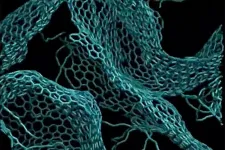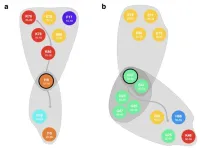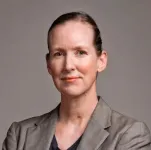(Press-News.org) The James Webb Space Telescope makes one of the most unexpected findings within its first year of service: A high number of faint little red dots in the distant Universe could change the way we understand the genesis of supermassive black holes. The research, led by Jorryt Matthee, Assistant Professor in astrophysics at the Institute of Science and Technology Austria (ISTA), is now published in The Astrophysical Journal.
A bunch of little red dots found in a tiny region of our night sky might be an unexpected breakthrough for the James Webb Space Telescope (JWST) within its first year of service. These objects were indistinguishable from normal galaxies through the ‘eyes’ of the older Hubble Space Telescope. “Without having been developed for this specific purpose, the JWST helped us determine that faint little red dots–found very far away in the Universe’s distant past–are small versions of extremely massive black holes. These special objects could change the way we think about the genesis of black holes,” says Jorryt Matthee, Assistant Professor at the Institute of Science and Technology Austria (ISTA), and lead author of the study. “The present findings could bring us one step closer to answering one of the greatest dilemmas in astronomy: According to the current models, some supermassive black holes in the early Universe have simply grown ‘too fast’. Then how did they form?”
The cosmic points of no return
Scientists have long considered black holes a mathematical curiosity until their existence became increasingly evident. These strange cosmic bottomless pits could have such compact masses and strong gravities that nothing can escape their force of attraction–they suck in anything, including cosmic dust, planets, and stars, and deform the space and time around them such that even light cannot escape. The general theory of relativity, published by Albert Einstein over a century ago, predicted that black holes could have any mass. Some of the most intriguing black holes are the supermassive black holes (SMBHs), which could reach millions to billions of times the mass of the Sun. Astrophysicists agree that there is an SMBH at the center of almost every large galaxy. The proof that Sagittarius A* is an SMBH in the center of our Galaxy with over four million times the Sun’s mass, earned the 2020 Nobel Prize in Physics.
Too massive to be there
However, not all SMBHs are the same. While Sagittarius A* could be compared to a sleeping volcano, some SMBHs grow extremely rapidly by engulfing astronomic amounts of matter. Thus, they become so luminous that they can be observed until the edge of the ever-expanding Universe. These SMBHs are called quasars and are among the brightest objects in the Universe. “One issue with quasars is that some of them seem to be overly massive, too massive given the age of the Universe at which the quasars are observed. We call them the ‘problematic quasars,’” says Matthee. “If we consider that quasars originate from the explosions of massive stars–and that we know their maximum growth rate from the general laws of physics, some of them look like they have grown faster than is possible. It’s like looking at a five-year-old child that is two meters tall. Something doesn’t add up,” he explains. Could SMBHs perhaps grow even faster than we originally thought? Or do they form differently?
Small versions of giant cosmic monsters
Now, Matthee and his colleagues identify a population of objects that appear as little red dots in JWST images. Also, they demonstrate that these objects are SMBHs, but not overly massive ones. Central in determining that these objects are SMBHs was the detection of Hα spectral emission lines with wide line profiles. Hα lines are spectral lines in the deep-red region of visible light that are emitted when hydrogen atoms are heated. The width of the spectra traces the motion of the gas. “The wider the base of the Hα lines, the higher the gas velocity. Thus, these spectra tell us that we are looking at a very small gas cloud that moves extremely rapidly and orbits something very massive like an SMBH,” says Matthee. However, the little red dots are not the giant cosmic monsters found in overly massive SMBHs. “While the ‘problematic quasars’ are blue, extremely bright, and reach billions of times the mass of the Sun, the little red dots are more like ‘baby quasars.’ Their masses lie between ten and a hundred million solar masses. Also, they appear red because they are dusty. The dust obscures the black holes and reddens the colors,” says Matthee. But eventually, the outflow of gas from the black holes will puncture the dust cocoon, and giants will evolve from these little red dots. Thus, the ISTA astrophysicist and his team suggest that the little red dots are small, red versions of giant blue SMBHs in the phase that predates the problematic quasars. “Studying baby versions of the overly massive SMBHs in more detail will allow us to better understand how problematic quasars come to exist.”
A “breakthrough” technology
Matthee and his team could find the baby quasars thanks to the datasets acquired by the EIGER (Emission-line galaxies and Intergalactic Gas in the Epoch of Reionization) and FRESCO (First Reionization Epoch Spectroscopically Complete Observations) collaborations. These are a large and a medium JWST program in which Matthee was involved. Last December, the Physics World magazine listed EIGER among the top 10 breakthroughs of the year for 2023. “EIGER was designed to study specifically the rare blue supermassive quasars and their environments. It was not designed to find the little red dots. But we found them by chance in the same dataset. This is because, by using the JWST’s Near Infrared Camera, EIGER acquires emission spectra of all objects in the Universe,” says Matthee. “If you raise your index finger and extend your arm completely, the region of the night sky we explored corresponds to roughly a twentieth of the surface of your nail. So far, we have probably only scratched the surface.”
Matthee is confident that the present study will open up many avenues and help answer some of the big questions about the Universe. “Black holes and SMBHs are possibly the most interesting things in the Universe. It’s hard to explain why they are there, but they are there. We hope that this work will help us lift one of the biggest veils of mystery about the Universe,” he concludes.
-
Shortly before publication of this release, the Space Telescope Science Institute (STScI) announced the selected program proposals for JWST’s third year of science operations. Among the programs that passed the competitive selection was Matthee’s proposal “Dissecting Little Red Dots: the connection between early SMBH growth and cosmic reionization”, which will total 45 hours on JWST.
END
Baby quasars: Growing supermassive black holes
ISTA: James Webb space telescope spots little giants in the deep past
2024-03-07
ELSE PRESS RELEASES FROM THIS DATE:
Carnegie Mellon researchers develop new machine learning method for modeling of chemical reactions
2024-03-07
Researchers from Carnegie Mellon University and Los Alamos National Laboratory have used machine learning to create a model that can simulate reactive processes in a diverse set of organic materials and conditions.
"It's a tool that can be used to investigate more reactions in this field," said Shuhao Zhang, a graduate student in Carnegie Mellon University's Department of Chemistry. "We can offer a full simulation of the reaction mechanisms."
Zhang is the first author on the paper that explains the creation and results of this new machine learning model, ...
Embargoed: For childhood cancer survivors, inherited genetic factors influence risk of cancers later in life
2024-03-07
Common inherited genetic factors that predict cancer risk in the general population may also predict elevated risk of new cancers among childhood cancer survivors, according to a study led by researchers at the National Cancer Institute (NCI), part of the National Institutes of Health. The findings, published March 7, 2024, in Nature Medicine, provide additional evidence that genetics may play an important role in the development of subsequent cancers in survivors of childhood cancer and suggest that common inherited variants could potentially inform screening and long-term ...
New method to predict medical risks decades ahead
2024-03-07
[Vienna, March 5 2024] — The world population is aging at an increasing pace. According to the World Health Organization (WHO), in 2023, one in six people were over 60 years old. By 2050, the number of people over 60 is expected to double to 2.1 billion.
“As age increases, the risk of multiple, often chronic diseases occurring simultaneously—known as multimorbidity—significantly rises,” explains Elma Dervic from the Complexity Science Hub (CSH). Given the demographic shift we are facing, this poses several challenges. On one hand, multimorbidity diminishes ...
City of Hope-developed chimeric antigen receptor (CAR) T cell therapy shows clinical activity in patients with aggressive brain tumors in a Phase 1 trial
2024-03-07
LOS ANGELES — A pioneering Phase 1 CAR T cell therapy trial for the treatment of glioblastoma at City of Hope, one of the largest cancer treatment and research organizations in the United States, demonstrates promising clinical activity against incurable brain tumors, according to research published today in Nature Medicine.
The study, which is the largest reported trial to date of CAR T therapy for solid tumors, evaluated CAR T cells engineered to target the tumor-associated antigen interleukin-13 receptor alpha 2 (IL13Rα2), a product invented at City of Hope and exclusively licensed by Mustang Bio Inc. (Nasdaq: MBIO), a Fortress Biotech Inc. (Nasdaq: ...
STI cases on the rise across Europe
2024-03-07
The findings reveal a troubling surge in cases of syphilis, gonorrhoea, and chlamydia, indicating a pressing need for heightened awareness of STI transmission, and the need to enhance robust prevention, access to testing, and effective treatment to address this public health challenge.
In 2022, the number of reported cases saw a significant increase compared to the previous year, with gonorrhoea cases rising by 48%, syphilis cases by 34%, and chlamydia cases by 16%. In addition, cases of lymphogranuloma venereum (LGV) and congenital syphilis (caused by transmission from mother to fetus) have also substantially increased.
These trends underscore the urgent need for ...
Foot-eye coordination: how our vision changes in rhythm with our walking
2024-03-07
For the first time, neuroscientists have established a link between shifts in our visual perception and the cadence of our steps while walking.
The research, published in Nature Communications, shows that the brain processes vision in a rhythmic manner, rising and falling in sensitivity in a cycle that corresponds to the rhythm of our steps. When swinging from one step to the next, human perception is good and reactions fast.
During footfall, however, our vision is not as sharp and reactions are slowed.
Lead author Dr Matthew Davidson from the School of Psychology at the University of Sydney said: “This work reveals a previously unknown relationship between perception ...
Researchers discover new cancer-fighting role for neutrophils
2024-03-07
In a study published in Cell on March 5, Prof. ZHANG Xiaoming at the Shanghai Institute of Immunity and Infection (SIII) of the Chinese Academy of Sciences and Profs. GAO Qiang, FAN Jia and YANG Li at Fudan University have uncovered an unexpected level of complexity hidden within neutrophils, which were previously thought to be a relatively uniform population of short-lived immune cells.
Using cutting-edge single-cell RNA sequencing technology, the researchers analyzed individual neutrophils across a remarkable 17 different cancer types from 143 patients. They revealed that neutrophils can adopt at least ...
Personality and mental health factors linked to vaping uptake
2024-03-07
University of Otago researchers have discovered three psychological factors that predict if a non-smoker will start vaping.
The study, published in the journal Drug and Alcohol Review, investigates how psychological traits related to personality and mental health predict the likelihood of vaping uptake over time in non-smoking adults.
Researchers, led by Professor Tamlin Conner of the Department of Psychology and Andre Mason of the Department of Psychological Medicine, analysed longitudinal data of more than 36,000 New Zealand adults from the New Zealand Attitudes and Values Study (NZAVS).
They found people who ...
Powerless mechanoluminescent touchscreen underwater
2024-03-07
Optical properties of afterglow luminescent particles (ALPs) in mechanoluminescence (ML) and mechanical quenching (MQ) have attracted great attention for diverse technological applications. Recently, a team of researchers from Pohang University of Science and Technology (POSTECH) has garnered attention by developing an optical display technology with ALPs enabling the writing and erasure of messages underwater.
The team, comprised of Professor Sei Kwang Hahn and PhD candidate Seong-Jong Kim from the Department of Materials Science and Engineering at the POSTECH, uncovered a distinctive optical phenomenon in ALPs. Subsequently, they successfully created ...
Missing disease-related gene identified in generalized pustular psoriasis
2024-03-07
A team from Nagoya University in Japan has identified previously unidentified gene variants that are associated with the development of generalized pustular psoriasis (GPP). The team’s findings, published in the Journal of the American Academy of Dermatology, offer hope for improving diagnosis and therapy.
GPP is rare, but its effects are often serious. People with GPP can experience recurrent flares of the disease, which include multiple erythematous lesions and sterile pustules over the whole body, often accompanied by fever ...
LAST 30 PRESS RELEASES:
Study finds brain care score can predict risk of stroke across racial groups
Key lung immune cells can intensify allergic reactions
Do hormones explain why women experience more gut pain?
New materials conduct ions in solids as easily as in liquids
Breakthrough of the Year: Renewable energy begins to eclipse fossil fuel-based sources
LLM use is reshaping scientific enterprise by increasing output, reducing quality and more
Introducing LightGen, a chip for ultra-fast, ultra-efficient generative AI
Astronomers see fireworks from violent collisions around nearby star
ACC/AHA issue new guideline on managing congenital heart disease in adults
Cosmic crash caught on camera
Is talented youth nurtured the wrong way? New study shows: top performers develop differently than assumed
Ants: An untapped resource in the development of antibiotics?
Archaeologists use AI to create prehistoric video game
Mitochondria migrate toward the cell membrane in response to high glucose levels
Tiny viral switch offers hope against drug-resistant bacteria
Most parents aware of early peanut introduction guidelines, but confused about details
HPV vaccine can protect against severe lesions of the vulva and vagina
Virtual care provision and emergency department use among children and youth
Quadrivalent HPV vaccine and high-grade vulvovaginal lesions
Insights into dry eyes gained from stem cell-derived tear glands
Researchers identify 166 human pluripotent stem cell lines available for use in clinical applications
Europa Clipper instrument uniquely observed interstellar comet 3I/ATLAS
UN University Report challenges climate change as sole trigger of Syrian Civil War, exposing governance failures in drought response
Real estate investment trust (REIT) acquisition associated with hospital closure and bankruptcy
New Raman imaging system detects subtle tumor signals
Boston Children’s receives a $7.5 million grant from Aligning Research to Impact Autism (ARIA) to provide clinical research coordination for the IMPACT Network
Spray-on antibacterial coating offers new protection for plants against disease and drought
ESMT Berlin study: What makes a first offer successful in negotiations
Groundbreaking ceremony marks the beginning of CTAO-South Array construction in Chile
Why swearing makes you stronger
[Press-News.org] Baby quasars: Growing supermassive black holesISTA: James Webb space telescope spots little giants in the deep past








